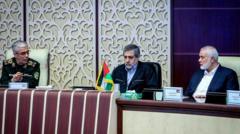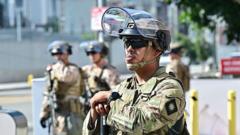With airstrikes on Iran's nuclear sites, the U.S. has officially entered the conflict and faces the challenge of managing Iran's retaliatory threats and the potential for broader regional instability.
**U.S. Escalates Military Involvement in Iran Conflict, Strikes Nuclear Sites**

**U.S. Escalates Military Involvement in Iran Conflict, Strikes Nuclear Sites**
In an unprecedented move, President Trump announces U.S. airstrikes targeting key Iranian nuclear facilities as tensions escalate in the region following Israel's military actions.
On June 21, 2025, President Trump confirmed that U.S. military forces have officially engaged in combat with Iran, marking a significant escalation in tensions. The announcement came after American warplanes launched strikes against critical Iranian nuclear facilities, including the Fordow site, recognized for its fortification and vital role in enriching uranium.
In a post on social media, Trump stated that “All planes are now outside of Iran air space,” emphasizing a complete bombing mission executed successfully. The targeted locations also included the Natanz enrichment facility and a third site suspected of housing near-weapons-grade uranium near Isfahan.
Amidst rising conflict, tensions between Israel and Iran have reached a boiling point. Israel earlier initiated strikes on Iranian military structures, prompting immediate retaliation from Iran, including missile launches targeting Israeli cities. Trump faced conflicting pressure as he deliberated the U.S. involvement while advocating for potential diplomatic talks.
After days of speculation regarding military action, U.S. airspace saw the deployment of B-2 bombers equipped with specialized bunker-busting munitions, designed to penetrate deep into Iranian territory. Initial reports indicated these bombers were operational as early as early morning hours when the strikes took place.
Iranian officials have decried the bombing as an act of war, with high-ranking military officials expressing that U.S. intervention would only complicate the already tense situation. In response to the airstrikes, Iran has escalated its threats to target U.S. military bases and allied interests within the Middle East.
Reporting from U.S. intelligence sources confirmed that the strikes were a response to recent Iranian advancements in nuclear capability. Trump, caught between his campaign's anti-interventionist rhetoric and increasing geopolitical pressure, described the goal of the airstrikes as preventing Iran from achieving nuclear bomb potential.
The unfolding crisis has prompted top officials from various regional countries to convene discussions on collective security strategies while citizens across the Middle East brace for possible repercussions from a broader conflict that could invoke traditional sectarian divisions in the region.
As evacuations of American citizens in the area begin and military resources shift into position, the international community watches closely, raising concerns over a potential rapid escalation of conflicts that have lingered through decades of fraught relations within the Middle East.
In a post on social media, Trump stated that “All planes are now outside of Iran air space,” emphasizing a complete bombing mission executed successfully. The targeted locations also included the Natanz enrichment facility and a third site suspected of housing near-weapons-grade uranium near Isfahan.
Amidst rising conflict, tensions between Israel and Iran have reached a boiling point. Israel earlier initiated strikes on Iranian military structures, prompting immediate retaliation from Iran, including missile launches targeting Israeli cities. Trump faced conflicting pressure as he deliberated the U.S. involvement while advocating for potential diplomatic talks.
After days of speculation regarding military action, U.S. airspace saw the deployment of B-2 bombers equipped with specialized bunker-busting munitions, designed to penetrate deep into Iranian territory. Initial reports indicated these bombers were operational as early as early morning hours when the strikes took place.
Iranian officials have decried the bombing as an act of war, with high-ranking military officials expressing that U.S. intervention would only complicate the already tense situation. In response to the airstrikes, Iran has escalated its threats to target U.S. military bases and allied interests within the Middle East.
Reporting from U.S. intelligence sources confirmed that the strikes were a response to recent Iranian advancements in nuclear capability. Trump, caught between his campaign's anti-interventionist rhetoric and increasing geopolitical pressure, described the goal of the airstrikes as preventing Iran from achieving nuclear bomb potential.
The unfolding crisis has prompted top officials from various regional countries to convene discussions on collective security strategies while citizens across the Middle East brace for possible repercussions from a broader conflict that could invoke traditional sectarian divisions in the region.
As evacuations of American citizens in the area begin and military resources shift into position, the international community watches closely, raising concerns over a potential rapid escalation of conflicts that have lingered through decades of fraught relations within the Middle East.






















